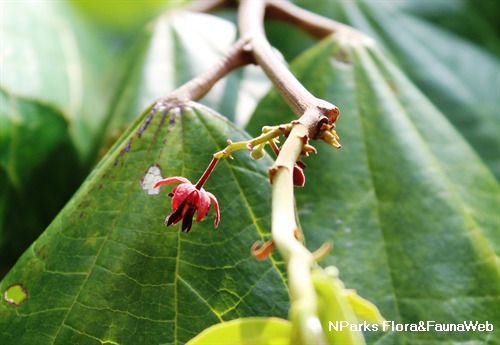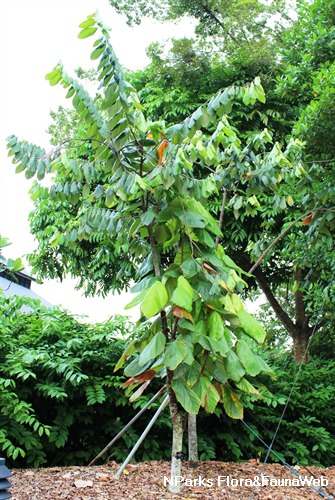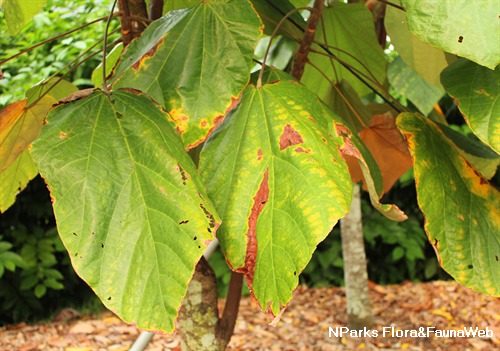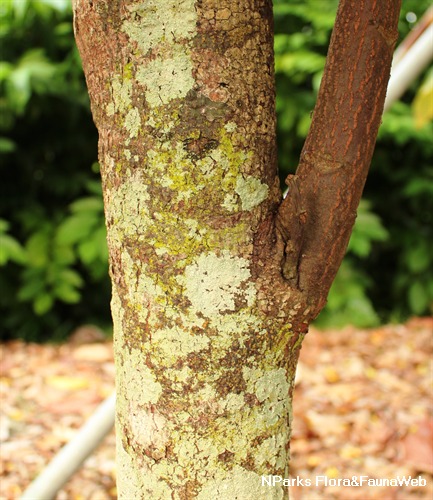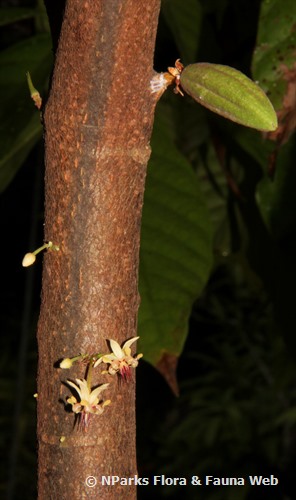
Back
Theobroma bicolor Bonpl.
| Family Name: | Malvaceae |
| Synonyms: | |
| Common Name: | Macambo tree, Jaguar tree, Pataxte |
Name
Classifications and Characteristics
| Plant Division | Angiosperms (Flowering Seed Plants) |
|---|---|
| Plant Growth Form | Tree |
| Lifespan (in Singapore) | Perennial |
| Mode of Nutrition | Autotrophic |
| Maximum Height | 25 m to 30 m |
Biogeography
| Native Distribution | Central and South America |
|---|---|
| Native Habitat | Terrestrial |
| Preferred Climate Zone | Tropical |
| Local Conservation Status | Non-native |
Description and Ethnobotany
| Growth Form | Tree up to 8 m tall in cultivation and 20 m tall in forests. |
|---|---|
| Foliage | Leaves have opposite arrangement. |
| Flowers | Flowers are small, borne on branches and purple in color. |
| Fruit | Fruits are elliptical and yellowish when ripe. There are 30-50 seeds per fruit, wrapped in yellow pulp. |
| Ethnobotanical Uses | Edible Plant Parts : Edible Fruits, Edible Seeds Food (Fruit or Vegetable): The pulp has a mildly sweet flavor and can be eaten fresh or made into juice, ice cream, and desserts. Seeds are consumed fried or boiled. |
Landscaping Features
| Landscape Uses | Parks & Gardens, Riverine |
|---|
Plant Care and Propagation
| Light Preference | Semi-Shade |
|---|---|
| Water Preference | Moderate Water, Lots of Water |
| Plant Growth Rate | Moderate |
| Rootzone Tolerance | Moist Soils, Well-Drained Soils |
| Propagation Method | Seed |
Foliar
| Mature Foliage Colour(s) | Green |
|---|
Floral (Angiosperm)
| Flower Colour(s) | Purple |
|---|
Fruit, Seed and Spore
| Mature Fruit Colour(s) | Yellow / Golden |
|---|---|
| Seed Quantity Per Fruit | Numerous (>20) |
Image Repository
Others
| Master ID | 32677 |
|---|---|
| Species ID | 7089 |
| Flora Disclaimer | The information in this website has been compiled from reliable sources, such as reference works on medicinal plants. It is not a substitute for medical advice or treatment and NParks does not purport to provide any medical advice. Readers should always consult his/her physician before using or consuming a plant for medicinal purposes. |

